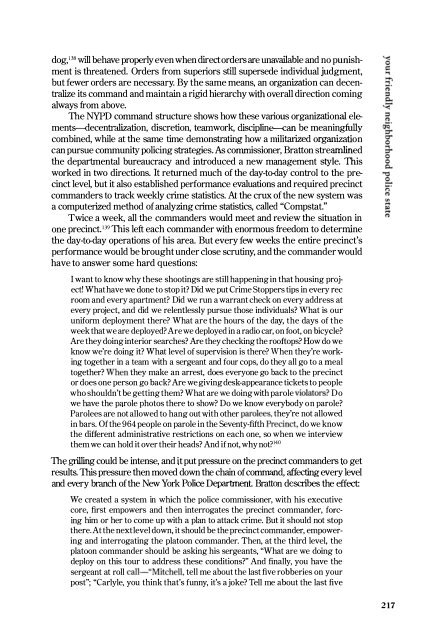Kristian Williams - Our Enemies in Blue - Police and Power in America
Kristian Williams - Our Enemies in Blue - Police and Power in America
Kristian Williams - Our Enemies in Blue - Police and Power in America
You also want an ePaper? Increase the reach of your titles
YUMPU automatically turns print PDFs into web optimized ePapers that Google loves.
dog,) 38 will behave properly even when direct orders are unavailable <strong>and</strong> no punishmentis threatened. Orders from superiors still supersede <strong>in</strong>dividual judgment,but fewer orders are necessary. By the same means, an organization can decentralizeits comm<strong>and</strong> <strong>and</strong> ma<strong>in</strong>ta<strong>in</strong> a rigid hierarchy with overall direction com<strong>in</strong>galways from above.The NYPD comm<strong>and</strong> structure shows how these various organizational elements----decentralization, discretion, teamwork, discipl<strong>in</strong>e-can be mean<strong>in</strong>gfullycomb<strong>in</strong>ed, while at the same time demonstrat<strong>in</strong>g how a militarized organizationcan pursue community polic<strong>in</strong>g strategies. As commissioner, Bratton streaml<strong>in</strong>edthe departmental bureaucracy <strong>and</strong> <strong>in</strong>troduced a new management style. Thisworked <strong>in</strong> two directions. It returned much of the day-to-day control to the prec<strong>in</strong>ct level, but it also established performance evaluations <strong>and</strong> required prec<strong>in</strong>ctcomm<strong>and</strong>ers to track weekly crime statistics. At the crux of the new system wasa computerized method of analyz<strong>in</strong>g crime statistics, called "Compstat."Twice a week, all the comm<strong>and</strong>ers would meet <strong>and</strong> review the situation <strong>in</strong>one prec<strong>in</strong>ct. m This left each comm<strong>and</strong>er with enormous freedom to determ<strong>in</strong>ethe day-to-day operations of his area. But every few weeks the entire prec<strong>in</strong>ct'sperformance would be brought under close scrut<strong>in</strong>y, <strong>and</strong> the comm<strong>and</strong>er wouldhave to answer some hard questions:I want to know why these shoot<strong>in</strong>gs are still happen<strong>in</strong>g <strong>in</strong> that hous<strong>in</strong>g project!What have we done to stop it? Did we put Crime Stoppers tips <strong>in</strong> every recroom <strong>and</strong> every apartment? Did we run a warrant check on every address atevery project, <strong>and</strong> did we relentlessly pursue those <strong>in</strong>dividuals? What is ouruniform deployment there? What are the hours of the day, the days of theweek that we are deployed? Are we deployed <strong>in</strong> a radio car, on foot, on bicycle?Are they do<strong>in</strong>g <strong>in</strong>terior searches? Are they check<strong>in</strong>g the rooftops? How do weknow we're do<strong>in</strong>g it? What level of supervision is there? When they're work<strong>in</strong>gtogether <strong>in</strong> a team with a sergeant <strong>and</strong> four cops, do they all go to a mealtogether? When they make an arrest, does everyone go back to the prec<strong>in</strong>ctor does one person go back? Are we giv<strong>in</strong>g desk-appearance tickets to peoplewho shouldn't be gett<strong>in</strong>g them? What are we do<strong>in</strong>g with parole violators? Dowe have the parole photos there to show? Do we know everybody on parole?Parolees are not allowed to hang out with other parolees, they're not allowed<strong>in</strong> bars. Of the 964 people on parole <strong>in</strong> the Seventy-fifth Prec<strong>in</strong>ct, do we knowthe different adm<strong>in</strong>istrative restrictions on each one, so when we <strong>in</strong>terviewthem we can hold it over their heads? And if not, why not?140The grill<strong>in</strong>g could be <strong>in</strong>tense, <strong>and</strong> it put pressure on the prec<strong>in</strong>ct comm<strong>and</strong>ers to getresults. 1his pressure then moved down the cha<strong>in</strong> of comm<strong>and</strong>, affect<strong>in</strong>g every level<strong>and</strong> every branch of the New York <strong>Police</strong> Department Bratton describes the effectWe created a system <strong>in</strong> which the police commissioner, with his executivecore, first empowers <strong>and</strong> then <strong>in</strong>terrogates the prec<strong>in</strong>ct comm<strong>and</strong>er, forc<strong>in</strong>ghim or her to come up with a plan to attack crime. But it should not stopthere. At the next level down. it should be the prec<strong>in</strong>ct comm<strong>and</strong>er, empower<strong>in</strong>g<strong>and</strong> <strong>in</strong>terrogat<strong>in</strong>g the platoon comm<strong>and</strong>er. Then, at the third level. theplatoon comm<strong>and</strong>er should be ask<strong>in</strong>g his sergeants. "What are we do<strong>in</strong>g todeploy on this tour to address these conditions?" And f<strong>in</strong>ally. you have thesergeant at roll call-"Mitchell, tell me about the last five robberies on yourpost"; "Carlyle. you th<strong>in</strong>k that's funny, it's a joke? Tell me about the last five217


